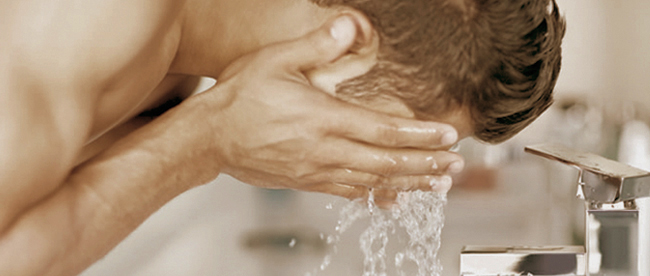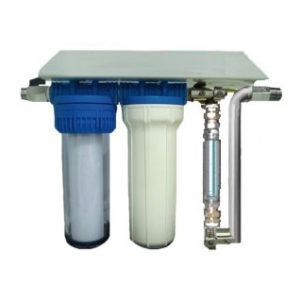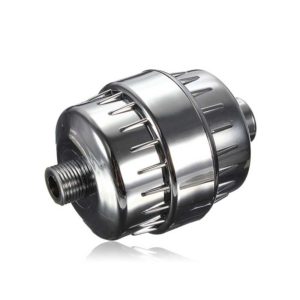Water softeners: are they the solution to skin problems?

Water softeners are often presented as beneficial systems for skin and hair health. Some people recommend them to solve problems of skin irritation, itching and dryness.
This widespread idea attributes to lime numerous negative effects on our body. However, in many cases the real problem is the presence of a much more harmful chemical element: chlorine. For this reason, installing a water softener to tackle these problems is not always the right solution.
To find the best solution to each problem, it is important to understand the role of chlorine in water treatment and the risks involved. Here are some of the most frequently asked questions.
.
What is chlorine?
Chlorine is a widely used chemical element as a disinfectant in the water treatment sector.
The chlorination process consists of adding chlorine to the water to disinfect it and ensure optimum hygienic conditions. It is the most widely used method of disinfecting and purifying water due to its low cost, easy application and safety, as long as it is used at the recommended doses.
.
What are the effects of chlorine in water?
Chlorine has two important effects when it comes into contact with water:
– Bactericidal effect: Chlorine eliminates bacteria and pathogenic organisms that can grow in water, as well as algae and fungi.
– Remaining effect: some of the chlorine remains active after a certain time of contact with water. This quantity is called residual chlorine and is necessary because it continues to disinfect the water until it reaches the points of consumption, such as taps and showers.
If residual chlorine is insufficient, water can accumulate bacteria and other microorganisms.
..
Are there health risks?
Chlorine is considered a very toxic element becasuse when it comes into contact with water it reacts with organic matter and can give rise to volatile chemical compounds, also known as disinfection by-products.
Exposure to these potentially carcinogenic compounds can occur in a number of ways: ingestion, dermal absorption or inhalation.
Chlorine can irritate the skin and eyes, and especially affects the respiratory system when small amounts are inhaled for short periods of time.
.
Should I remove chlorine in my facility?
Eliminating chlorine completely in our facilities is a very dangerous practice and totally inadvisable because it leaves us unprotected against the proliferation of viruses and bacteria.
When chlorine is eliminated, the accumulation of organic matter is favored, creating a layer called biofilm. This layer is composed of microorganisms and is responsible for more than half of bacterial infections.
On the other hand, the remaining effect of chlorine also disappears; that is to say, its disinfection power of the water during the whole journey to the points of consumption.
For this reason, no chemical modifications should be made to the general water inlet of the system.
Consumers are responsible for the maintenance of their installations, from the connection to the tap. This responsibility is reflected in Royal Decree 140/2003, which establishes the health criteria for the quality of water for human consumption.
For the same reason, it is also not recommended to install water softening systems that modify the natural composition of water, for example, by exchanging calcium for large amounts of sodium.
.
What are the risk facilities?
Under certain circumstances the risk of water infection increases:
- In homes that remain uninhabited for several days, where non-chlorinated water is stagnant in certain sections of the network.
- In the case of installations with old pipes, traces of heavy metal can be added to the filtered water (mercury, lead, cadmium, arsenic, etc.), as it runs a long way from the filter to the points of consumption.
- When the presence of chlorine is combined with very hard water, the risks are increased. Calcareous incrustations and corrosion favour the formation of a biofilm where bacteria such as Legionella can grow. In addition, these incrustations reduce the effectiveness of the biocides and act as thermal insulators, which means that more energy is consumed when heating the water.
.
What if I have an accumulation tank?
In an installation with a accumulation tank, the gases dissolved in the water gradually evaporate, including chlorine.
In summer, the temperature of the cold water rises to 20-30ºC, so that the evaporation of chlorine intensifies and it is necessary to add more quantities to maintain the optimum levels of water disinfection.
.
Are there alternatives for treating chlorine?
We can find in the market water treatment systems marketed as multifunction equipment that combine filtration, decalcification and disinfection.

Some of the most common ones use activated carbon filters to remove chlorine from the water and thus achieve a more pleasant taste and smell.
These systems are not recommended because they are installed in the general water supply of the house and remove chlorine before it enters the installations.
But there are alternative systems that remove chlorine and heavy metals, such as KDF (Kinetic Degradation Fluxion) filters.
It is a granulated filter media based on a copper-zinc alloy that reduces water contaminants.
These filters have antibacterial, algaecide and fungicide effects. Their advantage is that they can be installed in specific water points, e.g. in the shower, thus avoiding any complete change in the water quality of the entire system.
.
